Table of Contents
· Introduction
· Overview of Emergency Roof Tarping
· Importance of Immediate Action After Storm Damage
· Assessing Roof Damage After a Storm
· Materials Needed for Emergency Roof Tarping
· Step-by-Step Guide to Emergency Roof Tarping
· Temporary vs. Permanent Roof Repairs
· Common Mistakes to Avoid During Roof Tarping
· When to Call a Professional for Roof Tarping
· Preventing Future Roof Damage
Conclusion
Introduction
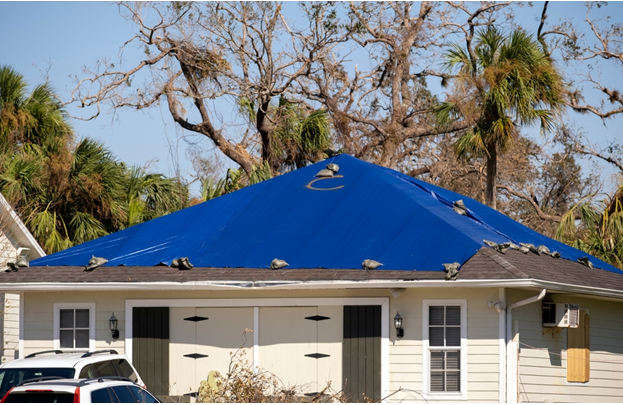
When storms strike, they can leave your home vulnerable, particularly the roof. Emergency roof tarping is an essential service that helps protect your property from further damage due to water infiltration, mold growth, and other related issues. This blog will discuss the importance of emergency roof tarping, steps to assess roof damage, necessary materials, and a guide for performing the task effectively. Understanding these practices can help safeguard your home and ensure prompt protection after severe weather events..
Overview of Emergency Roof Tarping
Emergency roof tarping involves the installation of a tarp over a damaged roof to prevent water from entering your home. This temporary solution is vital in the aftermath of severe weather events, such as hurricanes, heavy rains, or hailstorms. The tarping process acts as a barrier that mitigates immediate water damage while you prepare for more permanent repairs.
Importance of Immediate Action After Storm Damage
Taking swift action after a storm is critical. Delaying roof repairs can lead to further complications, such as structural damage and mold growth. By employing emergency roof tarping, homeowners can minimize the risk of costly repairs and health hazards. For instance, mold removal in Fort Myers, FL, can become necessary if water seeps into your home due to a delayed response. Prompt tarping not only protects your property but also your peace of mind.
Assessing Roof Damage After a Storm
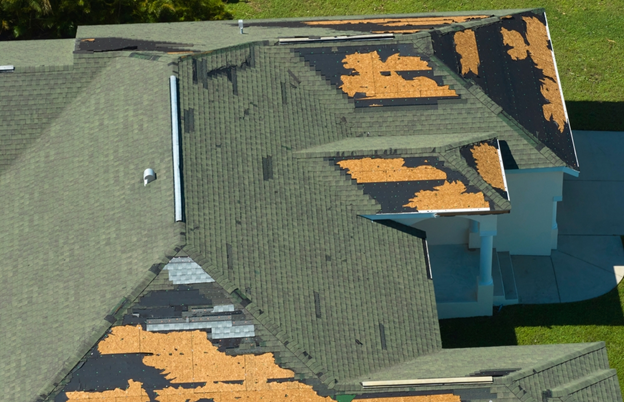
Before you can effectively tarp your roof, it’s essential to assess the extent of the damage.
Identifying Common Types of Roof Damage
Common types of roof damage include:
- Missing or Damaged Shingles: High winds can tear shingles off or lift them, exposing the underlayment.
- Punctures and Holes: Debris from storms can puncture roofing materials, leading to leaks.
- Deterioration: Aging roofs may experience deterioration, making them more susceptible to storm damage.
Safety Precautions Before Inspecting Your Roof
Safety should always be your first concern. Before climbing onto your roof, consider the following precautions:
- Wear Appropriate Gear: Use sturdy shoes with good grip and consider a helmet for protection.
- Check Weather Conditions: Avoid inspections during or immediately after a storm; wet roofs are slippery and dangerous.
- Use a Ladder Safely: Ensure your ladder is stable and secure before climbing.
When to Seek Professional Help
If the damage is extensive or you are uncomfortable inspecting your roof, it’s wise to call in a professional roof tarping service. A qualified fire damage contractor can assess the situation and provide necessary repairs, ensuring your safety and the integrity of your home.
Materials Needed for Emergency Roof Tarping
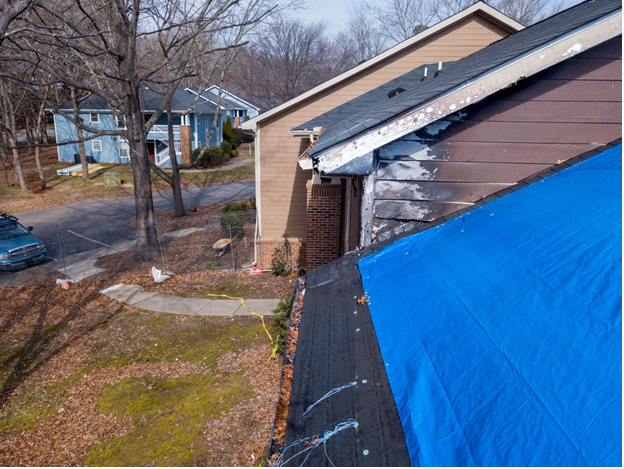
To tarp your roof effectively, you’ll need specific materials.
Essential Tools and Supplies
- Tarps: Choose high-quality, waterproof tarps designed for roofing.
- Ropes or Bungee Cords: These will help secure the tarp in place.
- Staple Gun or Roofing Nails: Useful for anchoring the tarp to the roof.
- Ladder: A stable ladder is essential for accessing your roof safely.
Types of Roof Tarps: Choosing the Right One for Your Home
When selecting a tarp, consider:
- Material: Polyethylene tarps are common due to their durability and waterproof properties.
- Size: Ensure the tarp covers the entire damaged area, extending beyond the edges.
- UV Protection: A tarp with UV protection will withstand sun exposure and last longer.
Importance of Waterproofing and Durable Materials
Choosing the right materials is crucial for effective tarping. A waterproof tarp not only prevents leaks but also protects your roof from further damage caused by wind and debris. Durable materials ensure the tarp remains intact during harsh weather conditions.
Step-by-Step Guide to Emergency Roof Tarping
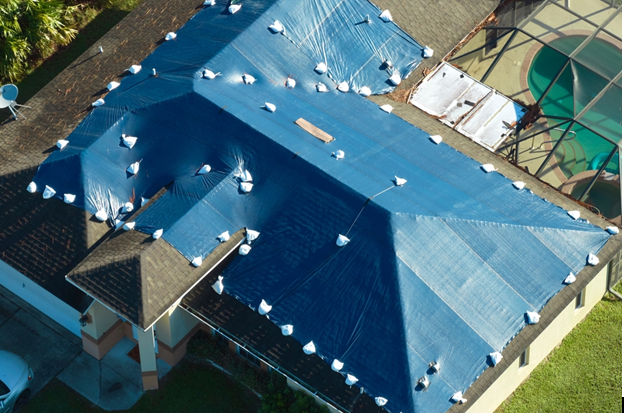
Now that you have assessed the damage and gathered your materials, follow this step-by-step guide for effective roof tarping.
Securing the Area and Ensuring Safety
Before you begin, ensure the area around your home is clear of debris and that pets and people are at a safe distance. This will prevent any accidents while you’re working.
Measuring and Cutting the Tarp for Accurate Coverage
- Measure the Damage: Determine the size of the area that needs coverage.
- Cut the Tarp: Cut the tarp to size, ensuring it extends at least three feet beyond the damaged area.
Anchoring the Tarp to Prevent Further Damage
- Position the Tarp: Lay the tarp over the damaged area, allowing it to drape over the edges of the roof.
- Secure the Tarp: Use roofing nails or a staple gun to attach the tarp to the roof. Ensure the edges are well anchored to prevent wind from lifting it.
- Tie Down: Use ropes or bungee cords to further secure the tarp, especially if high winds are expected.
Temporary vs. Permanent Roof Repairs
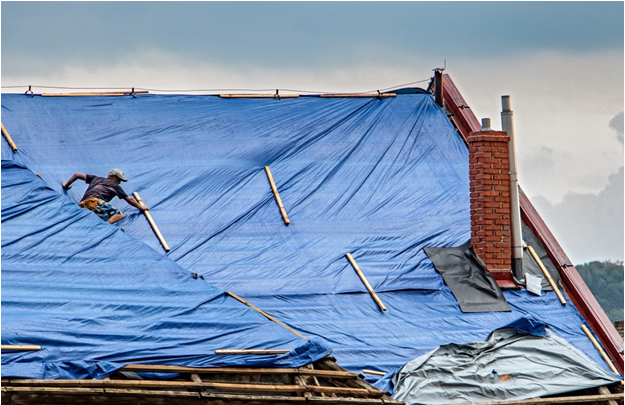
While emergency roof tarping is effective in the short term, understanding when to transition to permanent repairs is crucial.
How Long Can You Rely on a Roof Tarp?
Generally, a tarp can protect your roof for several weeks to months, depending on the weather conditions. However, it is essential to monitor the tarp regularly for any signs of wear or damage.
Benefits and Limitations of Temporary Roof Tarping
Benefits:
- Quick and effective protection against water damage.
- Cost-effective solution to prevent further issues.
Limitations:
- Not a permanent solution; requires timely follow-up repairs.
- Potential for water pooling on top of the tarp if not properly secured.
When to Transition to Permanent Roof Repairs
Once the immediate threat has passed, and you have temporarily tarped your roof, schedule a professional assessment. Permanent repairs may include replacing damaged shingles, sealing leaks, or even a full roof replacement.
Common Mistakes to Avoid During Roof Tarping
To ensure effective roof tarping, be mindful of these common mistakes.
Improper Tarp Placement and Securing
A poorly placed tarp can result in inadequate protection. Always ensure the tarp extends beyond the damaged area and is securely fastened.
Using the Wrong Materials
Using substandard tarps or inadequate fastening materials can lead to failures. Invest in high-quality products for the best results.
Ignoring Structural Damage
If your roof has significant structural damage, a tarp may not be sufficient. In such cases, consult a professional to evaluate and address the underlying issues.
When to Call a Professional for Roof Tarping

Complex Situations That Require Expert Help
Certain scenarios, such as severe roof damage or a lack of experience, warrant professional assistance.
How to Choose a Qualified Roofing Contractor
When selecting a contractor, consider:
- Experience: Look for professionals with experience in emergency roof tarping and repairs.
- Licensing and Insurance: Ensure they are licensed and carry insurance to protect you and your property.
- Reviews and Recommendations: Check customer reviews and ask for recommendations from friends or family.
The Role of Insurance in Roof Repairs and Tarping
Many homeowners’ insurance policies cover roof damage and repairs. Document any damage and the tarping process, and communicate with your insurance provider to understand your coverage options.
Preventing Future Roof Damage
While emergency roof tarping is essential, taking steps to prevent future damage is equally important.
Tips for Strengthening Your Roof Against Storms
- Regular Inspections: Have your roof inspected at least once a year, especially before storm season.
- Reinforce Roof Structures: Strengthening your roof with additional bracing can help withstand strong winds.
- Install Impact-Resistant Materials: Consider using impact-resistant shingles that are designed to endure harsh weather conditions.
Regular Maintenance and Inspections
Maintaining your roof through regular cleaning and inspections can help identify potential issues before they escalate. Clear debris, check for missing shingles, and ensure gutters are free from blockages.
Long-Term Roofing Solutions for Storm-Prone Areas
If you live in an area prone to severe weather, consider investing in a durable roofing system designed for your specific climate. Consult with roofing professionals about the best options available.
Conclusion

The Importance of Quick Action in Roof Tarping
Emergency roof tarping is an essential practice that can protect your home from further damage after a storm. By taking immediate action, assessing the damage, and effectively applying a tarp, you can mitigate risks and prevent costly repairs.
